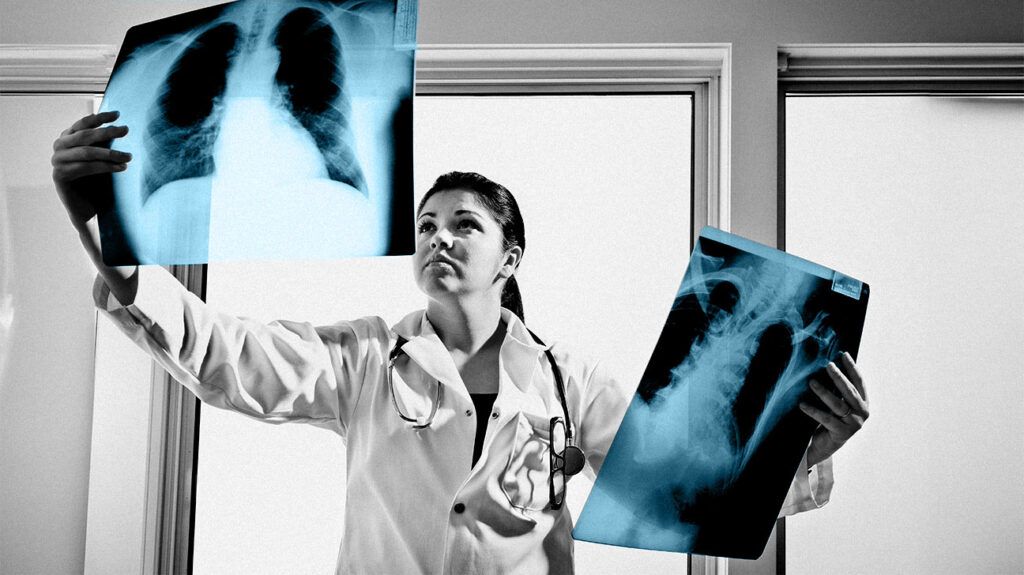A pulmonary embolism is a blood clot that blocks the lung’s arteries. Blood clots do not show on chest X-rays. However, these X-rays may help doctors rule out other health conditions with similar symptoms.
Pulmonary embolisms can reduce oxygen in the blood, increase pressure on the heart, and spike blood pressure in the lungs. They are potentially life threatening.
However, people can recover from pulmonary embolisms after receiving prompt and correct treatment. A person can speak with a healthcare professional about possible pulmonary embolism symptoms. A doctor may recommend several imaging scans, including CT, angiography, and ultrasound.
This article explains when X-rays may be useful, how doctors diagnose pulmonary embolisms, and how to treat the condition.

X-rays do not show blood clots directly, including pulmonary embolisms. However, they
- bone fractures
- pneumonia
- foreign objects
- some physical injuries
- dental problems
- some tumors
While X-rays cannot directly show an embolism, a
- Fleischner’s sign: Doctors see this sign when one of the main blood vessels in the lungs looks larger than usual. It can happen when the blood pressure in the lungs is too high or due to blockage by a pulmonary embolism.
- Knuckle sign: This occurs when one of the main blood vessels in the lungs suddenly gets smaller. This can happen when the blood flow reduces because of a clot.
- Westermark sign: X-rays show this sign when one part of the lung may look brighter than the rest. It can develop when less blood reaches that part of the lung due to small clots.
- Hampton’s hump: This is a wedge-shaped area of darkness at the edge of the lung. It can happen when there is bleeding or swelling in the lung tissue because of a clot.
These signs are rare and do not always indicate a pulmonary embolism. However, they may help doctors recognize and treat the condition.
Healthcare professionals may find it difficult to diagnose pulmonary embolism. It is also a
Symptoms of pulmonary embolism may include breathing difficulty or cardiac arrest (heartbeat stopping). These symptoms are not unique and may occur due to
- congestive heart failure
- vasovagal syncope
- acute coronary syndrome
- pneumonia
- cardiac arrhythmias
- stable angina
- certain tumors and cancer
- acute pericarditis
- pneumothorax
A chest X-ray may help a doctor rule out other conditions that cause breathlessness, such as tumors or pneumonia. They may also check the legs for a red, swollen, warm, or tender area — a possible sign of a deep vein clot. This type of clot can move up to the lungs and cause a pulmonary embolism.
Other scans and tests might include:
- Computed tomographic angiography (CTPA): This test uses a special type of X-ray and a contrast dye to analyze blood vessels.
- D-dimer blood tests: A D-dimer blood test can indicate blood clots have formed in the bloodstream.
- Pulmonary angiography: Unlike an X-ray, this scan can directly show a blood clot in the lungs.
- Pulmonary V/Q scan: This scan shows which parts of the lungs are getting enough air and blood supply.
- Ultrasound of the legs: Ultrasound measures blood flow and checks the veins for clots.
- Electrocardiogram (EKG): An EKG records heart activity and checks how the organ is functioning.
- Echocardiogram: An echocardiogram measures heart function and checks for raised blood pressure in the blood vessels that feed the lungs.
- MRI: Doctors usually only recommend an MRI for pregnant people if they suspect a pulmonary embolism. This may also apply to people who cannot tolerate the contrast in tests such as a CTPA.
Treating most pulmonary embolisms generally involves taking medication to prevent the clot from growing and reducing the risk of new clots. People with a large clot may need surgery to remove it to avoid it from becoming life threatening.
Treatments might include:
- Blood thinners: People who have to stay in the hospital to treat pulmonary embolism may receive an injection of blood-thinning medication. This medication does not shrink the clot but may stop it from getting larger.
- Thrombolytics: Some people with severe clots may need a type of medication called a thrombolytic that dissolves the clot. This can cause severe bleeding. Doctors may reserve using this for only life threatening clots.
- An inferior vena cava filter: A doctor may use a catheter, a long, flexible tube, to implant a filter into the vein running from the leg to the lungs. This can prevent blood clots from reaching the arteries of the lung.
- Embolectomy: This procedure can treat severe pulmonary embolism. A surgeon uses a catheter or a large cut to remove the blood clot directly.
A person with pulmonary embolism may not show symptoms at all. Up to
However, symptoms that may occur include:
- breathlessness
- chest pain
- coughing up blood
- blood clot in the leg (warmth, swelling, pain, and tenderness in the leg)
It is best to speak to a doctor upon noticing these symptoms. They may indicate a pulmonary embolism or other serious heart and lung problems.
A chest X-ray does not directly show pulmonary embolism. However, it may help a doctor rule out health problems that cause similar symptoms, such as pneumonia and some heart conditions. An X-ray may also show some physical lung changes that can indicate a blood clot.
Once a doctor has used an X-ray to guide diagnosis, they often order a CTPA, an ultrasound scan, and blood tests to locate clots. Treatment usually includes blood-thinning medications but may require surgery.
People should contact a doctor if they notice any symptoms of pulmonary embolism.
